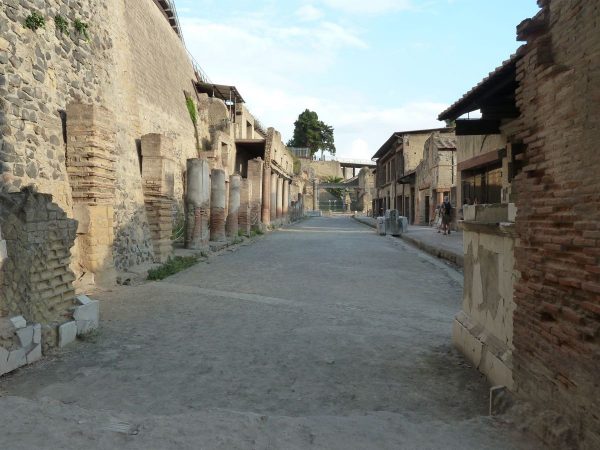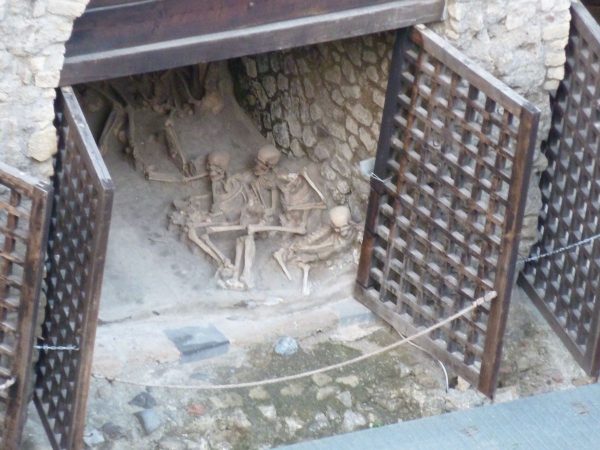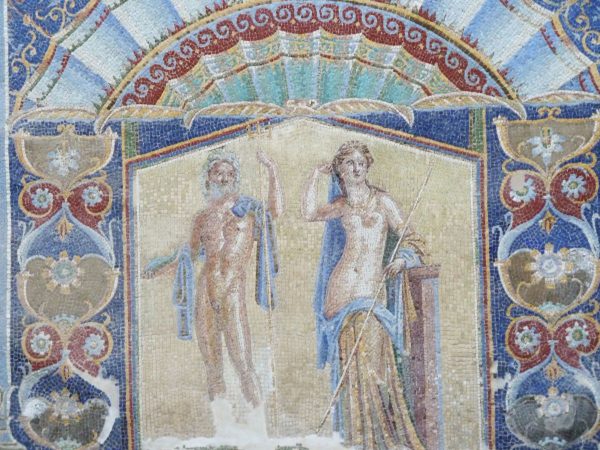It was in the afternoon after a long hot day in Pompeii that Hans and I stepped off the train to visit Herculaneum, another city destroyed during the eruption of Vesuvius in 79 AD.
We saw how the present town of Herculaneum is built on top of old Herculaneum. Excavation of the buried city ends abruptly at this point. The site was discovered in 1709 while large-scale excavation was undertaken in the 1920’s. Unfortunately, the site wasn’t maintained and had to be closed for safety reasons. In 2001, a restoration project began, making it possible to re-open. Herculaneum now has a visitors’ centre and an entrance from which you can see a good overview of the city’s layout.

After the crowds of Pompeii, Herculaneum was a breath of fresh air and it was so quiet, with deserted ancient streets we could explore without hindrance. Few other visitors were there and we felt we had the city to ourselves.
The remnants were preserved quite differently than in Pompeii. There are remnants of wooden window frames and doors and iron work as well. While Pompeii was buried under hot volcanic ash, Herculaneum was destroyed by a hotter pyroclastic flow of mud, gas, and ash. Pompeií’s inhabitants died instantly from the heat and then buried under hot ash preserving the outline of their bodies. In Herculaneum, until 1981 it appeared that most of the residents fled in the early stages of eruption. For now, we were blissfully unaware of this while admiring the splendid mosaics and artifacts from what must have been a fine lifestyle enjoyed by the wealthy inhabitants.
Herculaneum was small enough to explore easily. We reached everything but the boathouses before closing time but were able to see them from above. If we had only walked around a corner, we would have seen close up what happened to 300 or so residents who took shelter there. Escape by boat at this point would have been impossible because the sea rolled back exposing mud and stranded fish. There was no way out and their bodies were instantly vaporized by a pyroclastic flow, leaving only bones.

If you have only a short visit and must choose between Herculaneum and Pompeii, I would highly recommend Herculaneum for having a more powerful impact because it doesn’t have the tourist hordes. If you have the stamina – do both! In fact, why not visit other archaeological sites easily accessible by the train? The lesser known sites have the reputation of being hidden treasures and, having seen Herculaneum, I understand this. Pompeii is enormous and can handle the huge influx of visitors but a more intimate experience is only possible at the smaller sites. The quality of Herculaneum’s restoration makes it a desirable place to visit.
Many artifacts from Pompeii and Herculaneum are on display at the Naples National Archaeological Museum which is well worth a visit as the sites themselves have been stripped of artifacts, leaving only those firmly attached such as frescoes and mosaics and fountains.
Vesuvius still looms over the landscape waiting for the next eruption.

 +31 (0)50 367 71 97
+31 (0)50 367 71 97  info@connect-int.org
info@connect-int.org